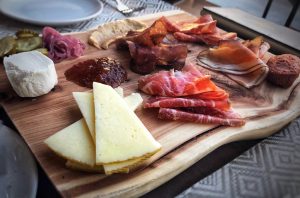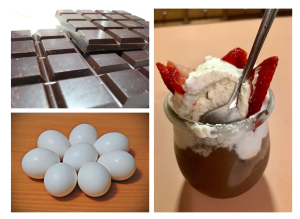11 Using CC-Licensed Works
Collections

Collections are similar to a charcuterie board: you collect all of the distinct types of cheeses, meats, olives, pickles, jam, and more and display them on a platter together.
Blending different components on a charcuterie in a blender or in one recipe is not only unappetizing, but it violates the definition of what a collection is and what the final result should be: an anthology of different food types kept together in their original and respective units.
Individual items on a charcuterie board can also be likened to license types that should not be re-mixed or combined due to license incompatibility.
Copyright & Collections
What does an organizer of a collection hold copyright to?
Only the copyright to the sequencing of the individual sources within the collection and to any individual contributions that they made to bring the sources together into a collection of units.
Going back to our charcuterie board example, a chef or home chef can take credit for the selection and organization of the individual savory and sweet items, as well as the display of the food items (which could be very creative!) and even for the handmade board itself, if they made it.
However they should not lay claim to making the cheese or the sausage since it was purchased. However, they do hold copyright to the jam if they made it themselves from scratch because it is their own unique contribution to the collection.
Adaptions, Derivatives, Remixes
An adaptation, sometimes called a derivative or a remix is a work based upon the Work, or upon the Work and other pre-existing works, such as a translation, adaptation, derivative work, arrangement of music or other alterations of a literary or artistic work, or phonogram or performance and includes cinematographic adaptations or any other form in which the Work may be recast, transformed, or adapted including in any form recognizably derived from the original…
Unlike our charcuterie board example, an adaption is like a recipe where we use different discrete works to create a new work.
Examples
Lumen Learning courses are great examples of adaptations where a mixture of open-licensed, copyrighted, and Public Domain content are combined to create a new work. While Lumen does provide footnotes at the of each page to indicate from which sources they drew in order to create the content on each page, it’s not always completely clear by looking closely at a paragraph or a sentence which source the material was from originally.
Example

“Eggs” by John Loo is licensed under CC BY 2.0
DeeAnn Ivie, Sous Vide Pots Du Creme, CC BY 4.0.
Attribution
This chapter “Using CC-Licensed Works” is licensed under a Creative Commons Attribution 4.0 International License and is a derivative of the September 2020 Creative Commons Certificate Course by Creative Commons, also licensed CC BY 4.0. DeeAnn Ivie adapted content from the Creative Commons Certificate Course adding it to the “Using CC-Licensed Works” chapter in the OER Toolkit: For UTSA Faculty, Instructional Designers & Librarians.
Media Attributions
- Charcuterie Society © vwcampin is licensed under a CC BY (Attribution) license
A work based upon the Work, or upon the Work and other pre-existing works, such as a translation, adaptation, derivative work, arrangement of music or other alterations of a literary or artistic work, or phonogram or performance and includes cinematographic adaptations or any other form in which the Work may be recast, transformed, or adapted including in any form recognizably derived from the original…

